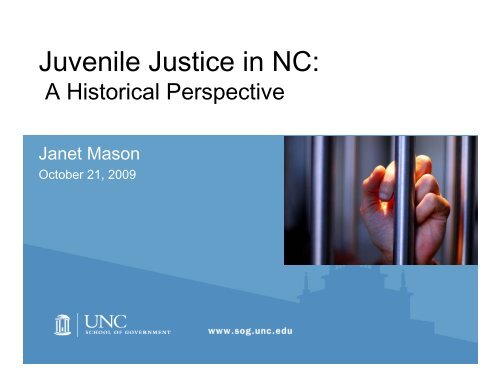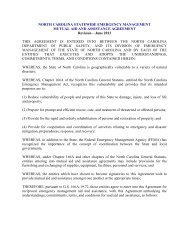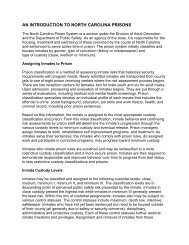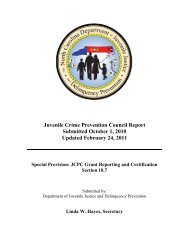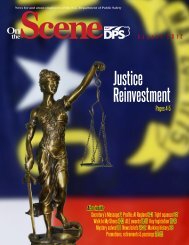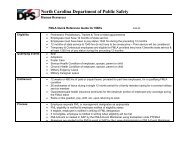Janet Mason Presentation on Juvenile Age - North Carolina ...
Janet Mason Presentation on Juvenile Age - North Carolina ...
Janet Mason Presentation on Juvenile Age - North Carolina ...
You also want an ePaper? Increase the reach of your titles
YUMPU automatically turns print PDFs into web optimized ePapers that Google loves.
The first <strong>Juvenile</strong> court in <strong>North</strong> <strong>Carolina</strong> wasestablished during the administrati<strong>on</strong> of ThomasW. Bickett, Governor from 1917 to 1921.Image source: N.C. Officeof Archives and History
Treatment of <strong>Juvenile</strong>s in Early America• no separate court for children• children treated much like adults• pris<strong>on</strong>ers not classified• c<strong>on</strong>cerns about housing children with older seriousoffenders• governors often pard<strong>on</strong>edyoung offenders
Early practice followed English comm<strong>on</strong> law:• up to age 7 –c<strong>on</strong>clusive presumpti<strong>on</strong> that child was incapableof criminal intent• age 7 to 14 –rebuttable presumpti<strong>on</strong> that child incapable ofcriminal intent• over age 14 –always prosecuted and punishedas adult
First special attenti<strong>on</strong> was in correcti<strong>on</strong>s:• houses of refuge• apprenticeship• rehabilitati<strong>on</strong> and discipline• industrial andreform schools• c<strong>on</strong>tinued use of adultpris<strong>on</strong>s
1907 legislati<strong>on</strong> authorized St<strong>on</strong>ewall Jacks<strong>on</strong>Manual Training and Industrial School• youth still were tried in criminal court• judge could commit those under 16 for indefiniteperiod of time
1915 – Probati<strong>on</strong> Courts Act• created special jurisdicti<strong>on</strong> for “delinquent” and“dependent” children under 18• separated juvenile and adult probati<strong>on</strong> anddetenti<strong>on</strong>• relied <strong>on</strong> counties for funding• not implemented uniformly• repealed in 1919
1919 – N.C. <strong>Juvenile</strong> Court Act• Nati<strong>on</strong>al Child Labor Committee study• proposed legislati<strong>on</strong> included children age18 or younger• legislature changed to under age 16• jurisdicti<strong>on</strong> could c<strong>on</strong>tinue to age of majority• court could transfer fel<strong>on</strong>y case of 14- or 15-year-old to superior court
The 1919 <strong>Juvenile</strong> Court Act applied tochildren who were• delinquent• neglected• dependent• truant•unruly•wayward• aband<strong>on</strong>ed•misdirected• disobedient toparents or bey<strong>on</strong>dtheir c<strong>on</strong>trol• destitute orhomeless• in danger ofbecoming so
1919 <strong>Juvenile</strong> Court Act• in every case, the issue before the court was:“Is the child in need of the care, protecti<strong>on</strong>,or discipline of the state?”• procedures were informal• in many other respects, resembled later juvenilecodes
1919 to 1969: Parens Patriae Ruled• laws held c<strong>on</strong>stituti<strong>on</strong>al• juveniles viewed as wards of state• cases recognized as “civil,” not “criminal”• benevolent purposes used to justify informalityand broad judicial discreti<strong>on</strong>• lawyers rarely involved• variety of studies and proposals aboutraising the age, but no changes
Emergence of <strong>Juvenile</strong> Rightsin Delinquency CasesU.S. Supreme Court– 1966 Kent v. U.S.– 1967 In re Gault– 1970 In re Winshiprecognized juveniles’ c<strong>on</strong>stituti<strong>on</strong>aldue process rights
1970: New N.C. <strong>Juvenile</strong> Code• juvenile cases began to look more like criminalcases• distinguished undisciplined and delinquent• still addressed all categories of juveniles• added due process protecti<strong>on</strong>s for delinquencycases
1980: New N.C. <strong>Juvenile</strong> Code• c<strong>on</strong>cern about growth in juvenile crime andserious and chr<strong>on</strong>ic offenders• focused <strong>on</strong> dispositi<strong>on</strong>s, “correcti<strong>on</strong>s,” and needfor community resources• c<strong>on</strong>tinued to address all categories of juvenilestogether• expanded due process protecti<strong>on</strong>s• expanded dispositi<strong>on</strong>al opti<strong>on</strong>s• lowered undisciplined age to 16• added emancipati<strong>on</strong> and expungement
1994: Special Crime Sessi<strong>on</strong>1. lowered from 14 to 13 the age at which– court must c<strong>on</strong>duct probable cause hearingsin fel<strong>on</strong>y cases– juvenile’s case may be transferred to superiorcourt– transfer mandatory for first degree murder2. first provisi<strong>on</strong> for use of delinquencyadjudicati<strong>on</strong> as aggravating factor in criminalcase
1997–1998: Governor’s Commissi<strong>on</strong> <strong>on</strong><strong>Juvenile</strong> Crime and Justice• developed recommendati<strong>on</strong>s for most recentrewrite of <strong>Juvenile</strong> Code.• recommended that age of delinquency jurisdicti<strong>on</strong>remain 16 and age of dispositi<strong>on</strong>al jurisdicti<strong>on</strong>increase, noting:‣ impact <strong>on</strong> overburdened juvenile system‣ public opini<strong>on</strong> in light of serious juvenilecrimes‣ exorbitant budgetary projecti<strong>on</strong>s
The 1999 <strong>Juvenile</strong> CodeG.S. Chapter 7B• separate subchapter for “delinquent and undisciplined”• no change in initial jurisdicti<strong>on</strong> age• no change in transfer for ages 13, 14, 15– mandatory for first degree murder– permissible all other fel<strong>on</strong>ies• raised undisciplined age back to 18• expanded dispositi<strong>on</strong>al jurisdicti<strong>on</strong> age• restructured dispositi<strong>on</strong>al opti<strong>on</strong>s• retained ‘reverse’ transfer authority of governor
Initial jurisdicti<strong>on</strong>• age at time of offense‣ minimum age: at least 6‣ maximum age: not yet 16• fel<strong>on</strong>y by juvenile age 13, 14, or 15:‣ can be initiated indefinitely, regardless of age(but <strong>on</strong>ly for probable cause and transfer after 18)• any other delinquent offense:‣ can be initiated <strong>on</strong>ly before juvenile is 18
Maximum <strong>Age</strong> of Dispositi<strong>on</strong>al Jurisdicti<strong>on</strong>After adjudicati<strong>on</strong>, jurisdicti<strong>on</strong> c<strong>on</strong>tinues:a. to age 18,b. to age 19 or 21 if extended (<strong>on</strong>ly mostserious cases), orc. until terminated by court order earlier thana or b.
Variety of <strong>Age</strong> Distincti<strong>on</strong>s in <strong>Juvenile</strong> Code• 6 youngest age of jurisdicti<strong>on</strong>• 10 youngest age for some fingerprinting,photographs, and commitment to YDC• 13 transfer possible; probable cause hearings• 14 youngest age to waive right to have parentpresent during interrogati<strong>on</strong>• 16 treated as adult for criminal c<strong>on</strong>duct• 18 maximum age for undisciplined jurisdicti<strong>on</strong>• 18 max. disp. jurisdicti<strong>on</strong> for less than E fel<strong>on</strong>y• 19 max. disp. jurisdicti<strong>on</strong> for B-E fel<strong>on</strong>ies• 21 max. disp. jurisdicti<strong>on</strong> for few most serious fel<strong>on</strong>ies
Other <strong>Age</strong> Designati<strong>on</strong>s• compulsory school attendance• abuse, neglect, dependency• motor vehicle• alcoholic beverages• certain criminal offenses• victims of certain crimes• marriage• child support
<strong>North</strong> <strong>Carolina</strong>and <strong>Juvenile</strong> <strong>Age</strong> Jurisdicti<strong>on</strong>1. almost unique positi<strong>on</strong> am<strong>on</strong>g states2. less flexibility than many states– no blended sentencing– no real reverse transfer– limited appeal procedures in transfer– no ‘youthful offender’ category3. ambivalence– open hearings, closed files– changing access to juvenile informati<strong>on</strong>4. history of studying but not changing age ofjurisdicti<strong>on</strong>
Nati<strong>on</strong>ally• Other states, most recently CT, have increased ages• U.S. Supreme Court– 1989: Stanford v. Kentucky“Impositi<strong>on</strong> of capital punishment for crime committedat age 16 or 17 did not violate evolving standards ofdecency and thus did not c<strong>on</strong>stitute cruel and unusualpunishment under the Eighth Amendment.”– 2005: Roper v. Simm<strong>on</strong>s“Executi<strong>on</strong> of individuals who were under 18 years ofage at the time of their capital crimes is prohibited byEighth and Fourteenth Amendments.”
Resources• Birckhead, Tamar R., <strong>North</strong> <strong>Carolina</strong>, <strong>Juvenile</strong>Court Jurisdicti<strong>on</strong>, and the Resistance to Reform.<strong>North</strong> <strong>Carolina</strong> Law Review, Vol. 86, No. 6, 2008.http://ssrn.com/abstract=1183022• Final Report of the Governor’s Commissi<strong>on</strong> <strong>on</strong><strong>Juvenile</strong> Crime and Justice. March 10, 1998.• 1979 Report of the <strong>Juvenile</strong> Code Revisi<strong>on</strong>Committee.


